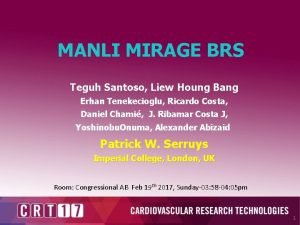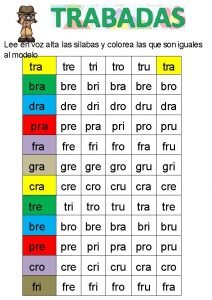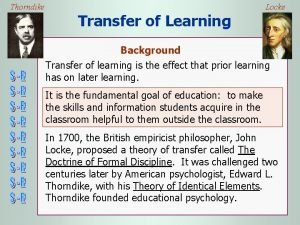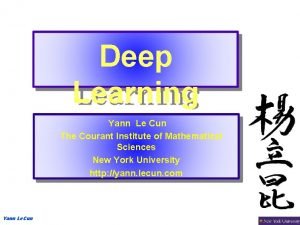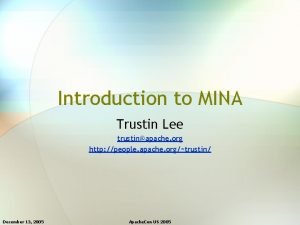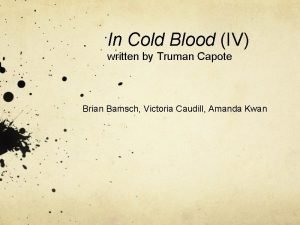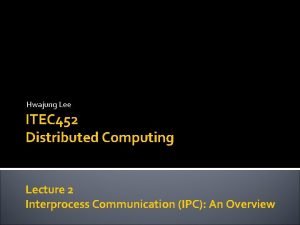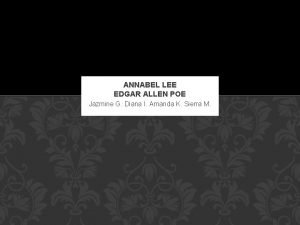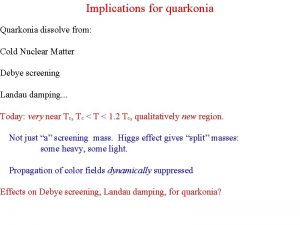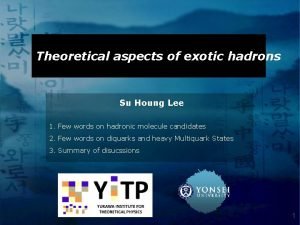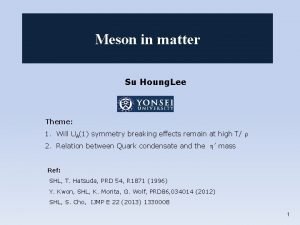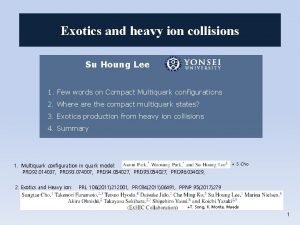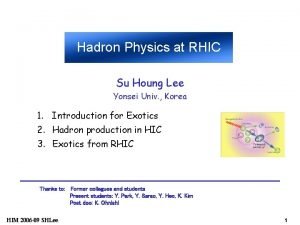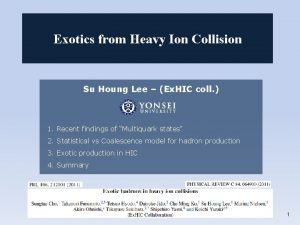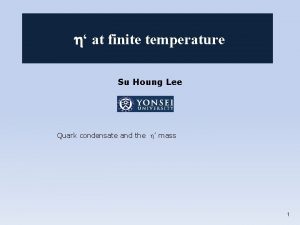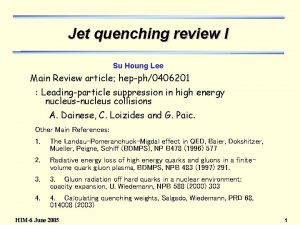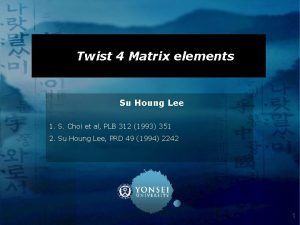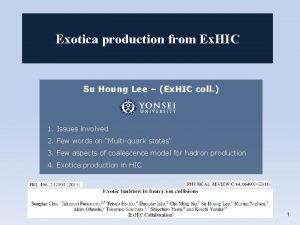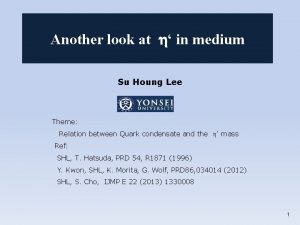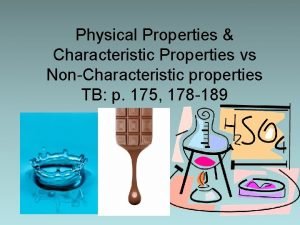Properties of Quarkonia at Tc Su Houng Lee


















- Slides: 18

Properties of Quarkonia at Tc Su Houng Lee In collaboration with Kenji Morita 1

J/y in Quark Gluon Plasma 1986: Hashimoto, 1986: Matsui, Miyamura , . . : Mass shift of J/ Satz : J/ y will dissolve at y Near Tc Tc T< 1. 6 Tc 1988: Hansson , Lee, Zahed : J/ y states in QGP 2004: Asakawa , Hatsuda : J/ y will survive up to 2 Confirmed by other lattice calculations: Datta etal. Tc T> 1. 6 Tc and potential model: Wong. . . S H Lee 2

J/y in Quark Gluon Plasma • Tc <T<2 Tc is important in HIC Kolb, Heinz, nucl-th/0305084 • Large uncertainty in lattice MEM Jakovac et al. hep-lat/0611017 • Tc <T<2 Tc is non perturbative region T=0 phenomenological approach? S H Lee J/y High T perturbative approach? Karsch hep-lat/0106019 3

How can we treat heavy quark system in QCD ? Properties of QGP from lattice S H Lee 4

G 2, E 2 and B 2 across Tc -- (quenched case) Using energy momentum tensor p and e local operators e/T 4 p/T 4 Lattice result for purge gauge (Boyd et al 96) <a/p B 2 >T =0 D<a/p G 2 >T <a/p E 2 >T Maximum at 1. 1 Tc Extraction from lattice: Morita, Lee (08) S H Lee 5

E 2 and B 2 across Tc -- (relation to potentials ? ) Manousakis, Polonyi, PRL 58 (87) 847 “Nonperturbative length scale in high T QCD” Shifman NPB 73 (80) Time W(S-T) = 1 - <a/p E 2> (ST)2 +… W(S-T) W(S-S) = 1 - <a/p B 2> (SS)2 +… a. Exp(-b. F) L Space L W(S-S) Space W(S-T) T< Tc Area T> Tc Perimete r <a/ p. E 2 > W(S-S) change Area <a/ p. B 2 > no change Area If <E 2> suddently increases across Tc, what will happen to J/y immersed in it ? S H Lee 6

Hydrogen Atom in an external E field <E >external S H Lee <E 2 >T 7

QCD 2 nd order Stark Effect (Peskin , Luke, Manohar ) D<a/p E 2 >T Attractive for ground state T/ Tc 1. 05 e 0 Dm J/ y -44 Me. V -105 Me. V 311 Me. V Dm U -4. 3 Me. V -10 Me. V 580 Me. V A non-perturbative method ? S H Lee 8

Basics in Heavy quark system Heavy quark propagation Perturbative treatment are possible because S H Lee 9

System with two heavy quarks Perturbative treatment are possible when S H Lee 10

Perturbative treatment are possible when S H Lee q 2 process 0 Photo production of open charm expansion parameter example m 2 J/ y > 0 Bound state properties Formalism by Peskin (79) J/y dissociation: NLO J/y mass shift: LO -Q 2 < 0 QCD sum rules for heavy quarks Predicted mhc <m. J/y before experiment 11

Including Temperature effects For High T > 2 Tc Separation scale For small and close to Tc S H Lee T 12

A reliable non perturbative approach near T c at q 2 < 0 Morita, Lee: ar. Xiv: 0704. 2021 (PRL 08) ar. Xiv: 0711. 3998 S H Lee 13

QCD sum rules for Heavy quark system T=0 Phenomenological side OPE r J/y Y’ s predicted Mhc<MJ/y before experiment S H Lee 14

QCD sum rules for Heavy quark system T near Tc Phenomenological side OPE r J/y D<G 2>+c<G 2> Y’ s D<G 2> Matching M OPE n-1 /M n from Phen Obtain constraint for to Dm J/ y and G For Detail Kenji Morita’s Poster S H Lee 15

Constraint for J/y Mass and Width above Tc If G=0 e/T 4 p/T 4 Dm Ge. V If Dm=0 G Me. V |Dm|+G =15 x. T, near Tc S H Lee 16

Summary Due to the sudden change in gluon condensates, there will be a critical behavior of J/y near Tc, |Dm|+ DG =150 Me. V from Tc to Tc + 10 Me. V • Model calculation is needed to get the changes separately, Use QCD Stark Effect ? From G =constraint- Dm (Stark effect) G QCD sum rule constraint with DG=0 S H Lee 17

Summary 1. ‘Order parameter’ of QCD Phase transition: Critical behavior of J/y near Tc, mass shift and width broadening from QCD sum rules, |Dm|+ DG =200 Me. V from 0. 98 T c to 1. 05 T c with Stark effect: Dm=-100 Me. V , G=100 Me. V at 1. 05 T c 2. A precursor phenomena takes place in nuclear matter Mass shift could be observed through anti proton project at GSI 3. Consequences in HIC? . Non trivial effects expected to cc , y’, U, U’… 4. S H Lee Remember the many findings from Stark, Zeeman, Anomalous Zeeman effects… Challenges for future experiments and analysis ! 18
 Liew houng bang
Liew houng bang Extensive vs intensive quantity
Extensive vs intensive quantity Is smell a physical property
Is smell a physical property Palabras con dra y cra
Palabras con dra y cra Where did general lee surrender to general grant?
Where did general lee surrender to general grant? Theories of transfer of learning
Theories of transfer of learning Yann lee cun
Yann lee cun Aparato fonador
Aparato fonador Trustin lee
Trustin lee Seunghak lee
Seunghak lee David lee architect
David lee architect Lowell lee andrews
Lowell lee andrews Dr derek lee
Dr derek lee Annabel lee biographical criticism
Annabel lee biographical criticism Arboles y sus partes
Arboles y sus partes Hwajung
Hwajung Annabel lee ballad
Annabel lee ballad Lee silverman voice technique
Lee silverman voice technique Technique de baermann et lee
Technique de baermann et lee
